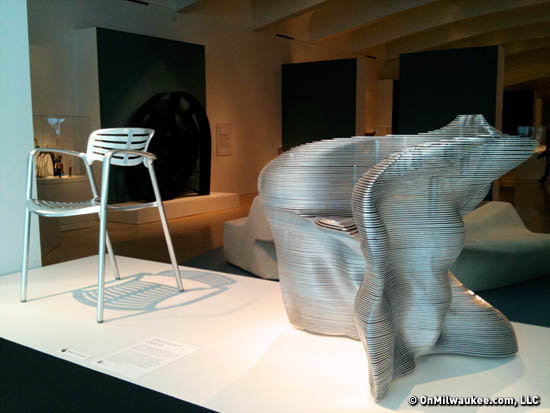Walk into "European Design Since 1985: Shaping the New Century" -- the new exhibition that opens Saturday at Milwaukee Art Museum and runs through Jan. 9 -- and you're confronted with two aluminum chairs.
The juxtaposition of those chairs, says Mel Buchanan, MAM's Mae E. Demmer assistant curator of 20th century design, puts visitors in the right frame of mind for the rest of the exhibition, curated by R. Craig Miller of the Indianapolis Museum of Art.
"What I did with these two objects," explains Buchanan, "is I took them out of the show and put them right front and center to kick off the discussion: what is design?"
The attractive but extremely practical chair on the left and the stunning but clearly unwelcoming example on the right impart a fundamental lesson on 20th century design.
"On the left here we have design as industry," says Buchanan. "This is a chair that is mass produce-able. It's at cafes all over the world. It fits the body, you stack it up, it can go inside, outside. This as a design is beautiful. But this is designed thinking about rational. How it will be produced? How cheap it could be made? It's very successful. This is one way of looking at design. Design as industry. In art history parlance that's Modernism with a capital 'M.'
"Right next to it we have another aluminum chair. This is the complete opposite. Sure, you could sit in it. But it's not comfortable. And that's not the point. (The designer) is working with ideas here: beauty, sculpture. Here is the idea that design can about much more than function. It can be an expression of an artistic concept.
"He starts with this lump of clay and molds it into this shape and turns it over to over to modern 3D graphing technology and then lets the computer determine these very precise aluminum slices. He puts it together: it's dazzling, it's visual. It's about much more than a chair. So this is what we would be what we would consider Post-Modern design -- it's design as art."
With more than 250 works -- mostly furniture and household items -- the exhibition includes some familiar objects, like plastic watering cans you've seen at IKEA, an instantly recognizable James Dyson vacuum and some pop art-influenced stuff you've likely seen in a CB2 or Design Within Reach catalog.
That's what makes a show like this one so engaging. It feels to relevant to our daily lives. We don't have to appreciate painting techniques, for example, or wonder how an abstract work ought to speak to us, or have studied art history. No, these objects remind us that the beauty of design is all around us.
But the works also force us into thinking about the discussion pitting form against function.
Some of the objects, like the watering cans, by Monika Mulder, are beautifully distilled and simplified bird shapes but are also quite functional.
But is Ron Arad's bookshelf -- dubbed "This Mortal Coil" -- the best system for storing your books? Maybe, maybe not. Does it matter?
That, of course, is both the point and not the point. Sometimes the point is simply no point at all. Except, perhaps, to explore, to experiment, to be playful, to create something that exists simply to be beautiful and nothing else.
In the show, we see some familiar names -- like Arad, Dyson, Philippe Starck and Mathias Bengtsson -- but also a range of new ones; the names of young designers like Tord Boontje, Hella Jongerius and Maarten Baas, whose work is exploring new territory in design.
Buchanan says she hopes that the show will help engage a new audience for the museum, too.
"Hopefully, it's a younger crowd that's maybe not been as involved (at MAM)," she says. "Hopefully we can reach them with this material. We're really, really excited about it. That's been nice for me being the curator working with this show to feel like all the young people on staff, and the designers and educators who are all on board are going to really love spending three months with this material, talking about it and promoting it."







